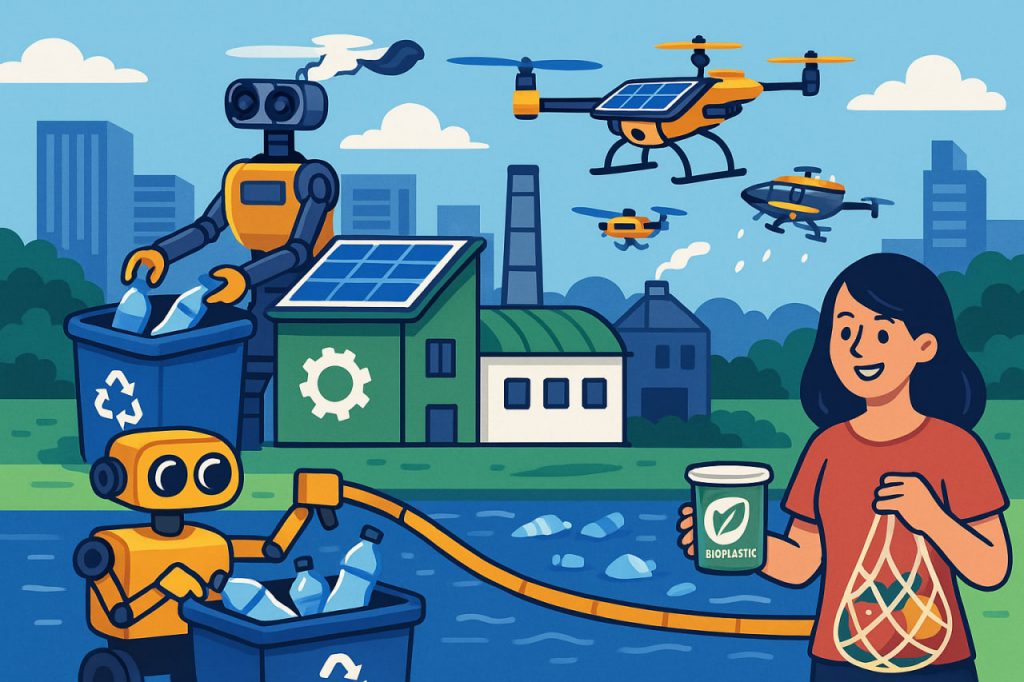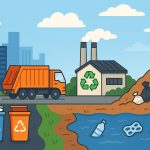The growing amount of waste on our planet has become one of humanity’s greatest environmental challenges. Every year, more than 2 billion tons of garbage are produced worldwide, much of which ends up polluting land, oceans, and the atmosphere. However, modern science and technology are developing innovative solutions that could turn waste into valuable resources, reduce pollution, and move us toward a zero-waste future.
Smart Waste Sorting Systems
Traditional recycling systems often fail because of contamination and improper sorting. New AI-powered sorting robots are changing this. Using cameras and machine learning algorithms, they can recognize and separate materials — plastics, metals, glass, and paper — with precision higher than 95%.
Companies like AMP Robotics and ZenRobotics already use robotic arms with advanced sensors to automatically sort tons of waste per hour, making recycling faster and more efficient. Such systems also reduce human exposure to hazardous materials.
Waste-to-Energy Technologies
Instead of letting trash rot in landfills, waste-to-energy (WTE) plants convert it into electricity and heat. Modern incineration facilities use high-temperature plasma arcs or gasification — burning waste in controlled environments to produce clean energy with minimal emissions.
Some countries, such as Sweden and Japan, have turned waste into a resource so effectively that they import garbage from other nations to power their cities. The future may also bring micro-WTE units, capable of turning household waste into electricity on a small scale.
Biodegradable and Smart Materials
Plastic waste is one of the world’s biggest environmental threats. Scientists are developing bioplastics made from renewable sources like corn starch, algae, or even food waste. These materials decompose naturally within months, not centuries.
Innovators are also creating smart materials that react to environmental conditions — for instance, packaging that dissolves in water or films that change color when food spoils, helping reduce unnecessary waste.
Chemical Recycling — Breaking Waste Back into Molecules
Unlike traditional mechanical recycling, which only melts and reshapes materials, chemical recycling breaks plastics back into their basic molecular components. This allows for infinite reuse without loss of quality.
Startups such as Loop Industries and Carbios are pioneering enzyme-based methods to “digest” plastics and turn them into pure raw materials ready for reuse. This process could revolutionize how industries handle plastic waste.
Ocean Cleanup and Drone-Based Waste Collection
To tackle the growing problem of ocean pollution, engineers have designed autonomous drones and floating barriers that collect plastics from rivers and seas. The Ocean Cleanup Project, for instance, uses massive floating systems that trap debris while allowing marine life to pass safely beneath.
Smaller, solar-powered marine robots like ClearBot patrol coastal waters, identifying and gathering waste using AI-driven cameras. Such innovations prevent millions of tons of plastic from reaching open oceans each year.
Circular Economy and Reuse Systems
The circular economy model encourages reusing materials instead of discarding them. Digital platforms now enable products to be shared, repaired, or repurposed instead of thrown away. Clothing and electronics companies are launching buy-back and repair programs that extend product lifespans.
In the near future, every item may come with a digital “passport”, showing where it was made, how it can be recycled, and its environmental footprint.
Composting and Bioengineering Solutions
Food waste accounts for nearly one-third of all global waste. Smart composting systems now allow homes and restaurants to turn organic leftovers into fertilizer in just a few days using heat, oxygen, and beneficial microbes.
Scientists are also exploring bioengineering, using fungi and bacteria that can “eat” plastics and break them down naturally. One strain of fungus discovered in the Amazon rainforest can decompose polyurethane, a common industrial plastic, in just a few weeks.
The Future: Zero Waste and Regenerative Design
The future of waste management lies in zero-waste cities — urban systems where all products are reused, recycled, or repurposed. Designers and engineers are creating buildings and factories that produce no waste at all, using closed-loop systems that mimic nature’s efficiency.
From AI-driven recycling robots to living microorganisms that digest plastic, innovation is leading humanity toward a world where waste no longer harms the environment but fuels progress and sustainability.
Interesting Facts
- Over 90% of waste can theoretically be recycled or reused with modern technologies.
- The Ocean Cleanup Project removes around 50,000 kilograms of plastic from oceans every few weeks.
- Biodegradable plastic made from seaweed can dissolve in water without harming marine life.
- Sweden recycles 99% of its waste, using the rest to produce energy.
Glossary
- Circular economy — a sustainable economic model focused on reuse and recycling rather than disposal.
- Bioplastic — plastic made from natural, renewable materials that decompose naturally.
- Gasification — a process that converts waste into synthetic gas for energy production.
- Chemical recycling — a method that breaks plastic into its basic chemical elements for reuse.
- Zero-waste — a philosophy aiming to eliminate waste through redesign and reuse.


